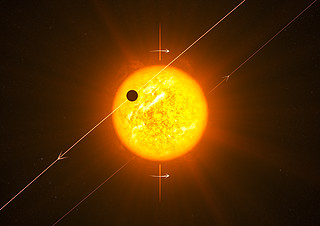The origin of solar systems was thought to be well understood. That is, until the discovery of planets which orbit their stars in the wrong direction.

Artist's rendition of newly found planet WASP 8b orbiting its star at a reverse angle compared to the star's rotation.
credit: ESO/L. Calçada
The prevailing theory is that solar systems begin as clouds of rotating gas and dust. The center of the cloud condenses into the star, and the remnants of material collect into planets of various sizes and distances. But the important point is that because the original cloud rotated in one direction, the ensuing star and planets should all continue to rotate in that same direction. Apparently, not so. In fact, there are now six known cases of planets that do not rotate in the same direction as their star.
As stated by Andrew Cameron of the University of St. Andrews, Scotland (hmm… wonder why he picked that school):
The new results really challenge the conventional wisdom that planets should always orbit in the same direction as their stars spin.
Did these planets start out orbiting their stars in the normal fashion and get knocked off course? Or is an entirely different mechanism for solar system formation required? One possibility is that planets can migrate into solar systems from other regions of space.
Hat tip and more detailed explanation: Bad Astronomy.
No comments:
Post a Comment